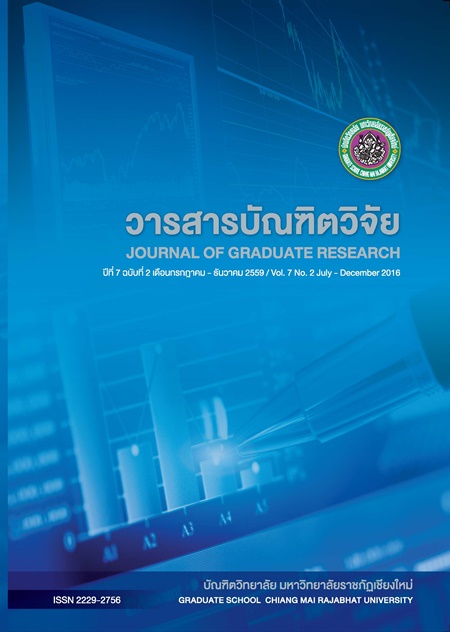การยอมรับการใช้ถุงอนามัยผู้หญิงรุ่นการผลิตที่ 2 ในผู้ติดเชื้อเอชไอวี โรงพยาบาลแม่สาย จังหวัดเชียงราย
Main Article Content
บทคัดย่อ
การวิจัยครั้งนี้เป็นการวิจัยเชิงสำรวจแบบตัดขวาง มีวัตถุประสงค์เพื่อศึกษาการยอมรับการใช้ถุงอนามัยผู้หญิงรุ่นการผลิตที่ 2 และปัจจัยที่มีความสัมพันธ์กับการยอมรับการใช้ถุงอนามัยผู้หญิงรุ่นการผลิตที่ 2 ในผู้ติดเชื้อเอชไอวี โรงพยาบาลแม่สาย จังหวัดเชียงราย ในช่วงเดือนกรกฎาคมถึงสิงหาคม พ.ศ. 2558 ศึกษาจากกลุ่มตัวอย่างจำนวน 233 คน โดยใช้วิธีการสุ่มตัวอย่างแบบมีระบบ จากจำนวนประชากรทั้งหมด 589 คน ซึ่งคำนวณโดยใช้สูตรของเครจซี่และมอร์แกน ที่ระดับความเชื่อมัน 95% ความคลาดเคลื่อน 5% เครื่องมือที่ใช้ในการเก็บรวบรวมข้อมูลคือ แบบสอบถามที่ผู้วิจัยสร้างขึ้นและได้ผ่านการตรวจสอบจากผู้เชี่ยวชาญและมีการทดสอบความเชื่อมั่นได้ค่าสัมประสิทธิ์แอลฟา ที่ระดับความเชื่อมั่น 0.92 สถิติที่ใช้วิเคราะห์ข้อมูลคือ Binary Logistic Regression
ผลการศึกษา พบว่า กลุ่มผู้หญิงที่ติดเชื้อเอชไอวี จำนวน 233 คน มีอายุเฉลี่ย 37.02 ปี ได้รับการรักษาด้วยยาต้านไวรัสสูตรมาตรฐานทุกราย มีค่ามัธยฐานของ CD4 count 520 cells/mm3 ทุกคนได้รับการแจกถุงอนามัยผู้หญิงรุ่นการผลิตที่ 2 และมีการยอมรับการใช้ คิดเป็นร้อยละ 68.24 กลุ่มที่มีความรู้เรื่องถุงอนามัยผู้หญิงรุ่นการผลิตที่ 2 ในระดับสูง มีการยอมรับการใช้ถุงอนามัยผู้หญิงรุ่นการผลิตที่ 2 มากกว่ากลุ่มที่มีความรู้ระดับปานกลาง 2.73 เท่า อย่างมีนัยสำคัญทางสถิติ (Adjusted OR 2.73, 95% CI 1.11 – 6.72) และกลุ่มผู้หญิงที่ติดเชื้อเอชไอวีที่มีแรงจูงใจในระดับมากที่สุด ยอมรับการใช้ถุงอนามัยผู้หญิงรุ่นการผลิตที่ 2 มากกว่ากลุ่มที่มีแรงจูงใจในระดับมากถึง 3.93 เท่า อย่างมีนัยสำคัญทางสถิติ (Adjusted OR 3.93, 95% CI 1.98 – 7.79)
สรุป ถุงอนามัยผู้หญิงรุ่นการผลิตที่ 2 ได้รับการยอมรับอย่างดีจากกลุ่มผู้หญิงที่ติดเชื้อเอชไอวี ปัจจัยด้านความรู้เรื่องถุงอนามัยผู้หญิงที่ถูกต้องและแรงจูงใจมีผลต่อการยอมรับการใช้ถุงอนามัยผู้หญิง จึงควรมีการรณรงค์ให้ความรู้เรื่องถุงอนามัยผู้หญิงที่ถูกต้องและมีการจูงใจที่ดี เพื่อให้เกิดการยอมรับการใช้ถุงอนามัยผู้หญิงเป็นวิถีชีวิตโดยปกติของประชาชนในการป้องกันการตั้งครรภ์ ป้องกันโรคเอดส์และโรคติดต่อทางเพศสัมพันธ์ รวมถึงลดความเสี่ยงจากมะเร็งปากมดลูก
ACCEPTABILITY OF FEMALE CONDOM (FC2) USE IN HIV INFECTED WOMEN AT MAESAI HOSPITAL, CHIANGRAI PROVINCE, THAILAND.
This study was a cross-sectional survey, aiming to assess the acceptability of female condom (fc2) use and factors associated with the acceptance of female condom (fc2) in HIV infected woman at Maesai hospital, Chiang Rai province, Thailand. A representative sample of 233 HIV infected womanfrom 589 casesattending HIV clinic wereincludedinthestudy.Survey sample was calculated apply in Krejcie and Morgan formula, with 95% confidence interval and a margin of error of 5%. Sampling approach was systematic sampling method. The content validity of the questionnaire was checked by 3 experts and also reliability of motivation was tested in a pilot sample of 30 people. The Cronbach alpha was 0.92. Binary logistic regression was used for analysis.
Result: The median age of 233 HIV infected woman was 37.02 years. The median CD4 count was 520 cells/mm3 . Everyone received first line antiretroviral therapy. All samples received female condom (fc2) and the acceptability rate was 68.24%. The knowledge and motivation had significant association with the acceptability of female condom (fc2). The woman with high level of knowledge of female condom (fc2) accepted to female condom (fc2) more than the woman with moderate level of knowledge 2.73 times. (Adjusted OR 2.73, 95% CI 1.11- 6.72). The women withhighlevel of motivationacceptedtheuseof femalecondoms (fc2) more than woman with lower motivation3.93times. (Adjusted OR3.93, 95% CI 1.98 -7.79). Conclusion: The HIV infected women in this sample, highly accepted the use of female condom (fc2). Theknowledgeand motivation werekeyfactors influencinghow well femalecondom (fc2) was accepted. The result may suggestthat knowledge and motion are important for promoting femalecondom (fc2) widelyusedby womenforpreventionofSexualTransmittedInfection(STI), cervix cancer including pregnancy.


